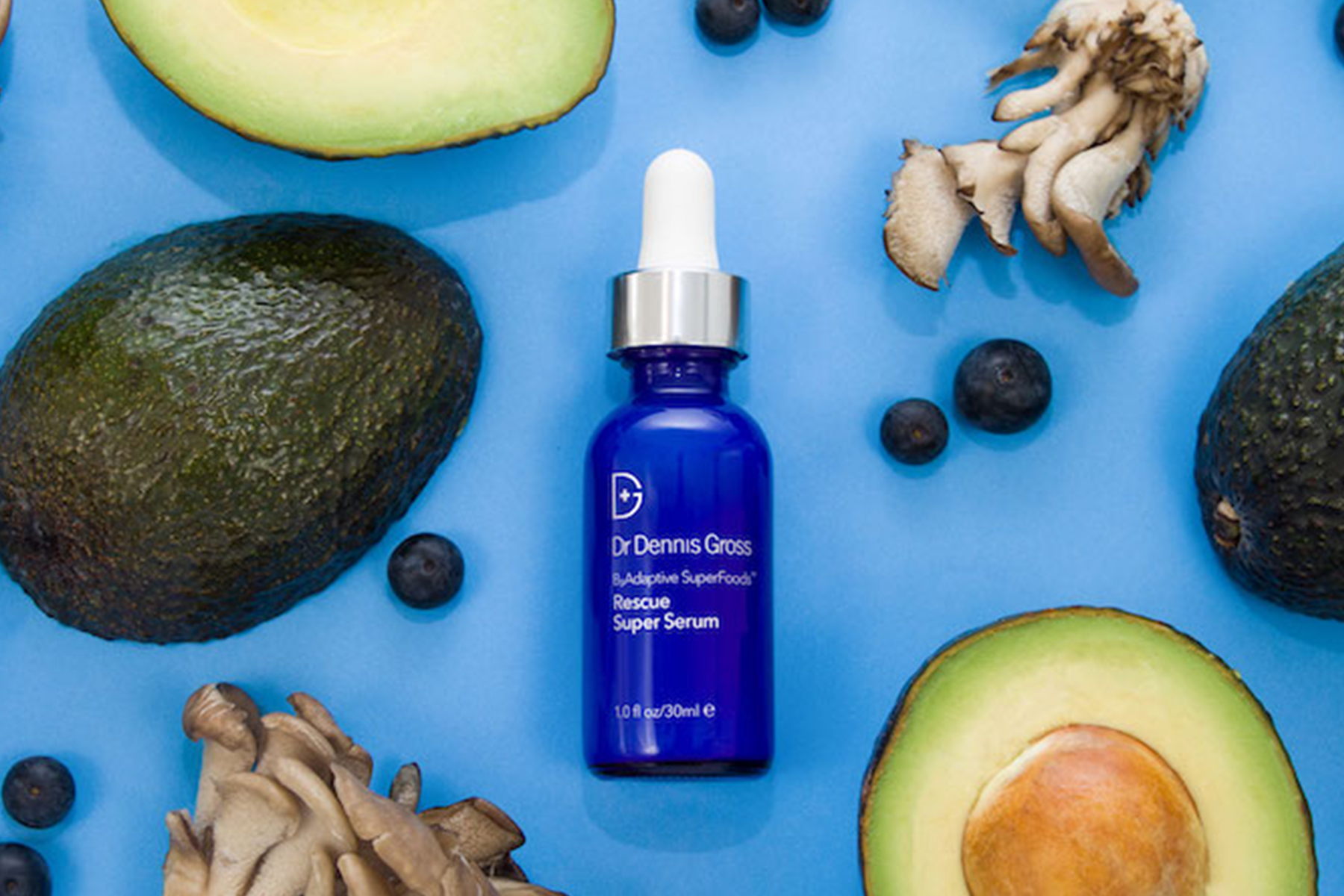The+Source
Superfoods sound like something that would be on the menu at Avengers HQ, but they’re actually widely available to us mere mortals and—if you’re following the USDA’s dietary guidelines—probably already a part of your daily diet. (Hint: Colorful fruits and vegetables play a major role.) But what you ingest doesn’t have a direct line to your complexion’s appearance, although eating poorly is pretty much guaranteed to make you look less than ideal. If you want to get the benefits of superfoods into your face, you need to apply those ingredients topically. But first, know what you’re asking for.
Superfoods – a (very) brief overview
Superfoods are nutritionally dense fruits and vegetables (also some meats and dairy) that are full of the antioxidants, vitamins, phytochemicals, and essential fatty acids known to contribute to good human health. There’s no hard-and-fast rule as to what qualifies something as a superfood, but the ones that are universally agreed upon are likely what you’d expect. For example, every smoothie’s BFFs, blueberries and kale, are superfoods; a russet potato is not.
How Superfoods Work & Benefits of Superfoods
One of the many benefits of superfoods is that they’re so multifaceted. A single superfood can contain antioxidants (to neutralize free radicals), anti-inflammatories (to counteract the effects of stress, environmental and otherwise), and essential fatty acids (to optimize skin’s barrier function). As part of a balanced diet, superfoods can have amazing health benefits, such as helping to prevent heart disease, warding off certain types of cancer, and reducing your chance of diabetes. As previously noted, the superfoods you eat will also improve your skin’s appearance, but in a more roundabout manner.
The quickest way to see superfoods’ impact on your face is via topical skincare. There, superfoods will do everything from boosting collagen production and increasing moisture levels to reducing the appearance of hyperpigmentation and calm redness. The trick is getting all those superfood superpowers into skin. A DIY avocado face mask will feel great and leave your skin soft. However, the key, “super” parts of the avocado won’t be able to make it past the skin’s lipid barrier, which is where they need to go in order to generate real, long-term—and most importantly, visible—improvement. Instead, to be effective, superfoods have to be encapsulated in a liposome (an empty sphere with a lipid exterior). As you may remember from your high school chemistry class, like attracts like. The skin’s lipid barrier allows the liposome (and its contents) past the velvet rope and straight into the VIP room (aka the skin cell). And your skin gets all the ingredient benefits of the superfood delivered right to its door.
Key Superfoods in Skincare
Variety is the spice of life. It’s also a good idea when you’re looking at the list of superfoods in your skincare. Superfoods have a lot of general characteristics in common, but there are enough subtle differences between them that one mix of superfoods might be best for an eye cream, while another blend could be better for a skin serum. You’ll be able to make an informed decision if you know what to expect from each superfood for skin. Here are the eight most potent superfoods in topical skincare:
Avocado: You love it for guacamole, but avocado has so much more to offer, beyond being the perfect margarita accompaniment. Avocados are full of vitamins A, C, and E, as well as omega-3 fatty acids. This makes them an antioxidant (yay), as well as an anti-inflammatory (double yay). The peptides in avocados help stimulate hyaluronic acid synthesis, keeping skin hydrated, and those peptides also increase cell turnover, leading to plumper skin.
Cacao: Most people are familiar with the cacao bean after it’s roasted and becomes cocoa. But cacao itself is worth a second look. It possesses a high level of antioxidants and contains trace minerals, such as selenium and zinc, that have skin benefits. Plus, cacao is an anti-inflammatory (good news for acne sufferers), and it decreases stress hormone levels (more good news for anyone plagued by breakouts).
Coffea arabica: You likely know it by its more common name, the coffee plant. Coffea arabica is rich in antioxidants—in particular, ferulic acid, which is an antioxidant that makes all other antioxidants work better. Coffee also contains caffeine (surprise, surprise), which increases circulation and helps reduce inflammation. Extracts of Coffea arabica have been shown to repair signs of sun damage and minimize destructive enzymes in the skin that can lead to collagen breakdown.
Kiwi: The tangy green fruit is packed with antioxidants C and E, and oil from its seeds is full of Alpha-linolenic acid, part of the Omega-3 fatty acid family. As a result, kiwi not only helps protect skin from free radicals, but it also keeps skin’s barrier function running smoothly. But that’s not all. Kiwi contains folate, which is the natural form of vitamin B9, a nutrient essential to the formation of new cells (like, say, skin-firming collagen ones). Plus, kiwi assists in controlling sebum production, for a balanced complexion.
Perilla sprout: Perilla is an herb with antioxidant and soothing properties. It’s often used to counteract hyperpigmentation due to aging or hormonal changes. High in linoleic acid, an antibacterial, perilla sprout can also help wipe out the bacteria that lead to breakouts.
Plum: Three varieties indigenous to Australia are particularly prized for their off-the-charts levels of antioxidant vitamin C.
Burdekin plum: Not only is it an antioxidant, but Burdekin plum (Pleiogynium Timoriense) also has the ability to increase skin hydration, both immediately and over the long term.
Illawarra plum: Illawarra plums (Podocarpus elatus) have seven times the antioxidant level of blueberries, so that’s saying something. They also help repair DNA damage, which is an additional bonus.
Kakadu plum: Of the three plum varieties highlighted here, Kakadu plums (Terminalia Ferdinadiana) may be most deserving of the hype. That’s because they contain the highest concentration of vitamin C of any plant—100 times that of an orange (likely explaining Kakadu plum’s popularity in skincare). They also boast vitamins A and E. And Kakadu plums are antibacterial, which makes them handy for treating existing blemishes and preventing future ones from appearing. Plus, they’re anti-inflammatory, which helps minimize the redness that occurs during the pimple-treatment process.
Discover Dr. Dennis Gross Superfood Skincare
Dr. Dennis Gross Skincare offers the superfoods your skin will love with our proprietary B₃Adaptive SuperFoods™ Complex, powered by microencapsulated niacinamide, superfoods, and adaptogens. These skincare products and the powerful superfoods in them are clinically proven to treat the 5 signs of stress-induced aging: redness, worry lines, flareups, dullness & dehydration.
For more skincare tips beyond superfoods from the experts at Dr. Dennis Gross, check out our blog’s newest content today. Shop the collection of Dr. Dennis Gross bestselling skincare backed by dermatologists.
